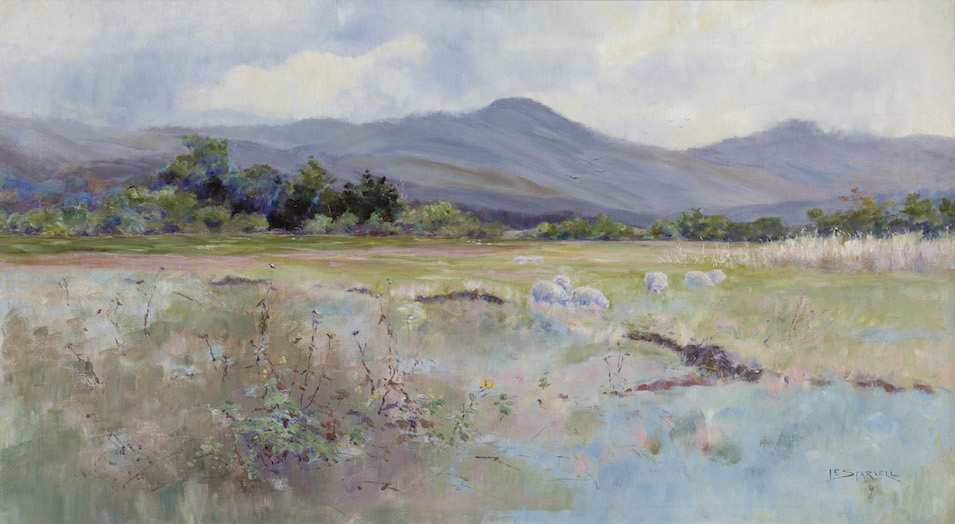Glenalvon, Murrurundi
Jessie Scarvell

Details
- Artist
- Jessie Scarvell
- Title
- Glenalvon, Murrurundi
- Year
- 1895
- Medium
- oil on canvas
- Size
- 50 x 89 cm
- Details
signed lower right: J.E. Scarvell 95
Exhibited
Sixteenth Annual Exhibition, Art Society of New South Wales, Sydney, September 1895, cat. no. 74
Further Information
Scarvell was a student of William Lister Lister and exhibited regularly with the Art Society of New South Wales in the 1890s. She was an exponent of Australian Impressionism and painted en plein air and her work is represented in the S.H. Ervin collection and the Art Gallery of NSW. Her paintings depicting bright green sweeping fields against a purple mountainous backdrop were praised by critics of the time.
“Miss J.E. Scarvell is probably at her best in “Mountain, Mead, and Stream, (no. 68), for this view of the Liverpool Range, with its purple tints, green fields, and winding stream, is sympathetically wrought.” Art Society Review, SMH, 28 September 1895, p.7
“Miss J.E. Scarvell in “Wyangerie, the Northern Borderland of New South Wales” (No. 31), successfully treats an expansive foreground of rich pasture covered with high grass, divided only by a belt of distant scrub from the chain of purple cloud-capped hills which bound the horizon. This is one of the best works Miss Scarvell has ever exhibited.” Art Society Review, SMH, 10 October 1896, p.7
Scarvell was selected to be included in the Exhibition of Australian Art in London organised by the Trustees of the Art Gallery of New South Wales and held at Grafton Galleries in September 1898. She was represented by five paintings including (Liverpool Range, Murrurundi, NSW). The exhibition featured 114 artists, including the well-known leaders of the Australian Impressionist movement, Streeton; Roberts; Conder; McCubbin; as well as a number of women artists, whose names have not become as celebrated today.
The subject of Glenalvon, Murrurundi depicts an area Scarvell painted on several occasions, the rural landscape around the mountains of the Liverpool Ranges in the Upper Hunter region of NSW. The pastoral town of Murrurundi is surrounded by mountains, located on the banks of the Pages River, a tributary of the Hunter River and was the terminus of the northern train line from 1872. There is a harmonious use of colour, with the muted soft purples, grey and green of the background contrasted against the brighter green, blue and touches of pink in the foreground.
The viewer's eye is attracted by the detailed thistle foliage, echoed in the grasses across the stream, with the white sheep in-between. Textured brush marks and soft light colours give way to a stronger band of green which draws our eye back to the purple mountain range, birds wheeling in the sky amid an aura of calm in this celebration of pastoral beauty.
The painterly marks, particularly evident in the depiction of the stream and grassy bank, and the focus point of yellow flowered pasture weed are reminiscent of archetypical Australian Impressionist paintings such as Charles Conder’s Herrick’s Blossom c.1888 and Arthur Streeton’s Golden Summer, Eaglemont 1889.
It is likely Scarvell was well aware of artworks in the collection of the Art Gallery of New South Wales, such as Ashton’s A Solitary Ramble 1888; Streeton’s Still Glides the Stream…1890 and Cremorne Pastoral 1895, which all entered the collection the year they were painted.
Glenalvon, Murrurundi was included in the Art Society of NSW annual exhibition of 1895, illustrated the catalogue and is believed to be in its original frame.
Scarvell is represented in the Art Gallery of New South Wales, as well as the S.H. Ervin Gallery, Sydney. A number of paintings by Jessie Scarvell were gifted to the National Trust in 2004 and exhibited at the S. H. Ervin Gallery in 2012, bringing an awareness to this female artist of the Australian Impressionist School and her oeuvre, which appears to have been created over a short period of perhaps six years in the 1890s, prior to her marriage.
